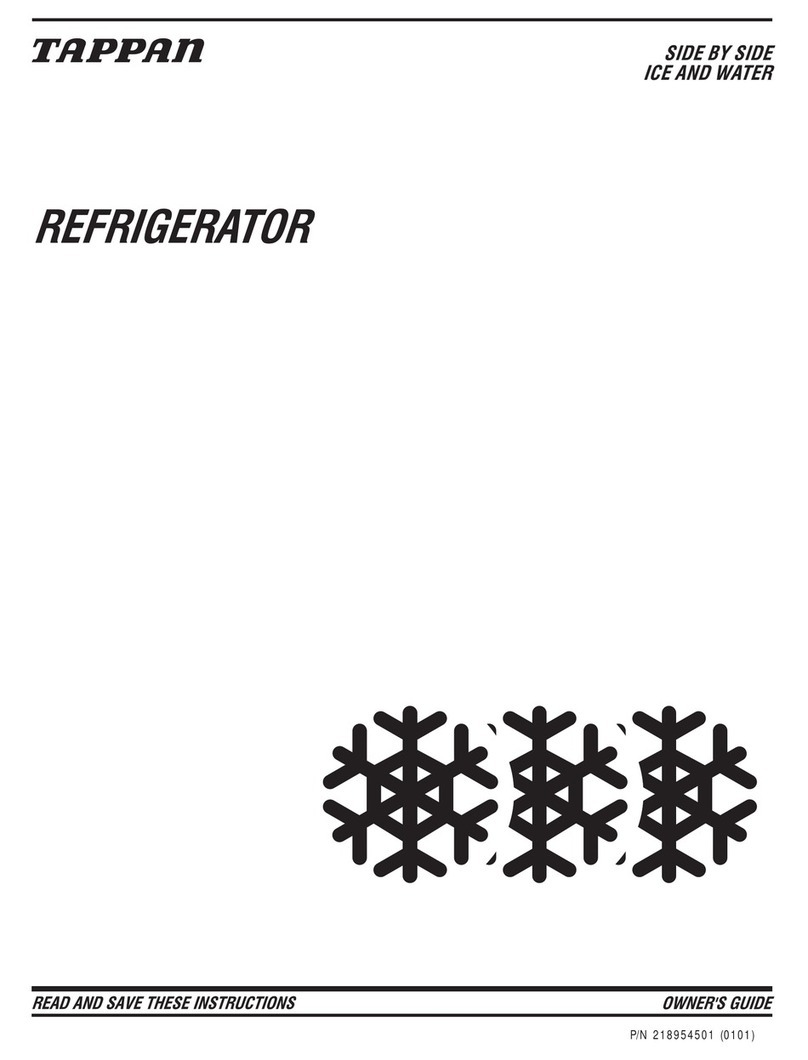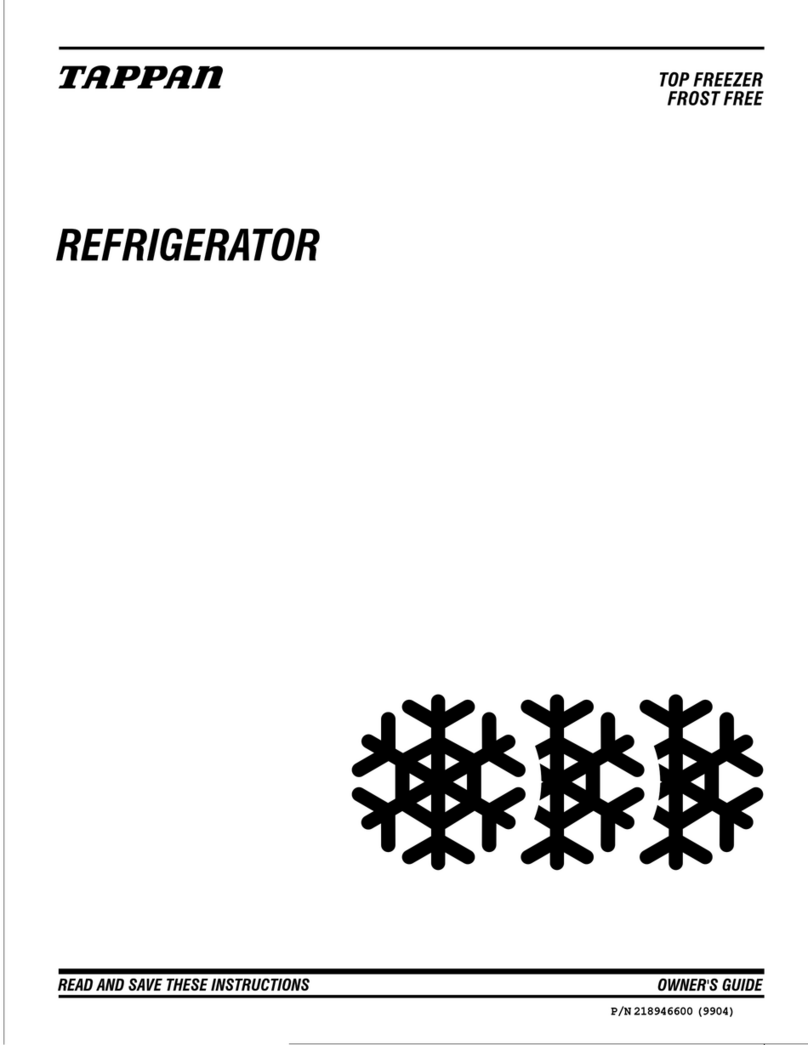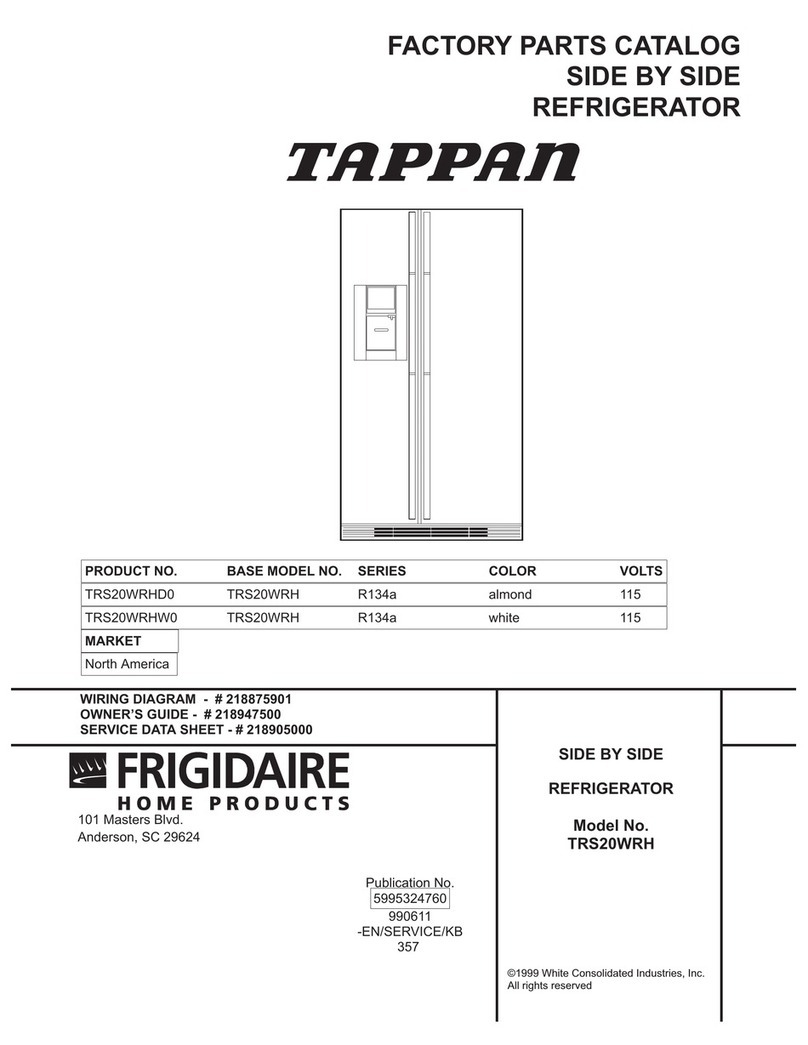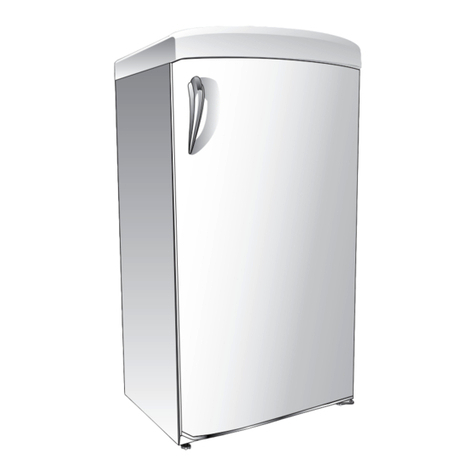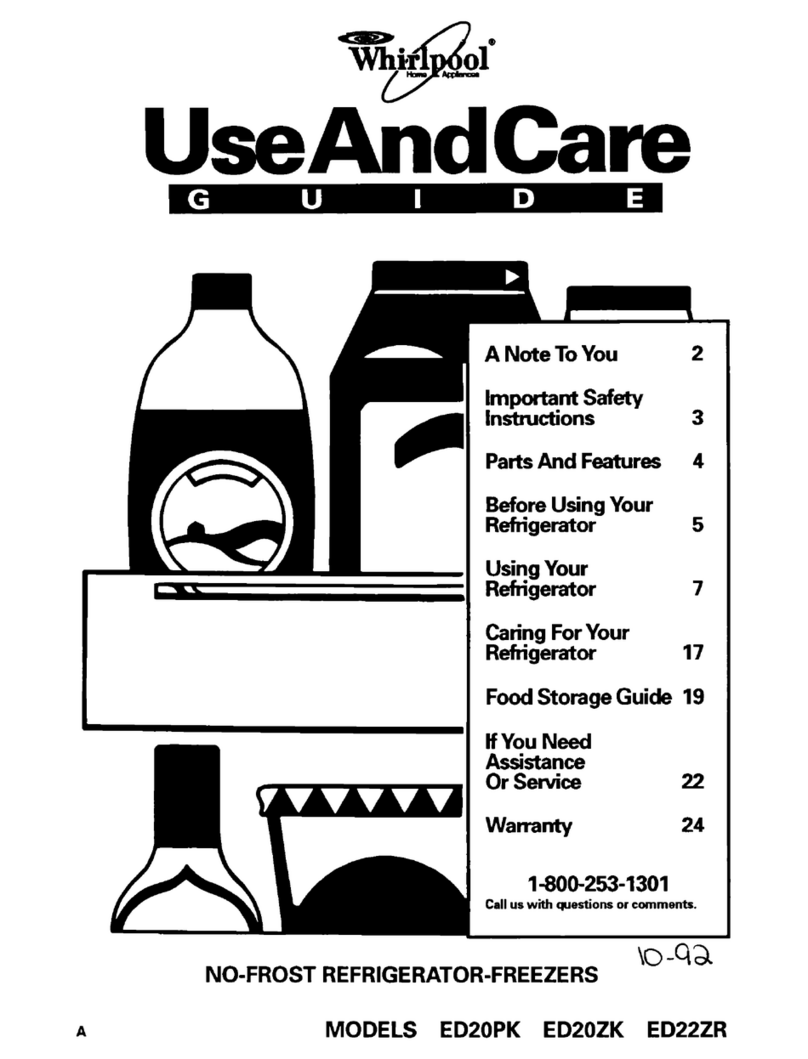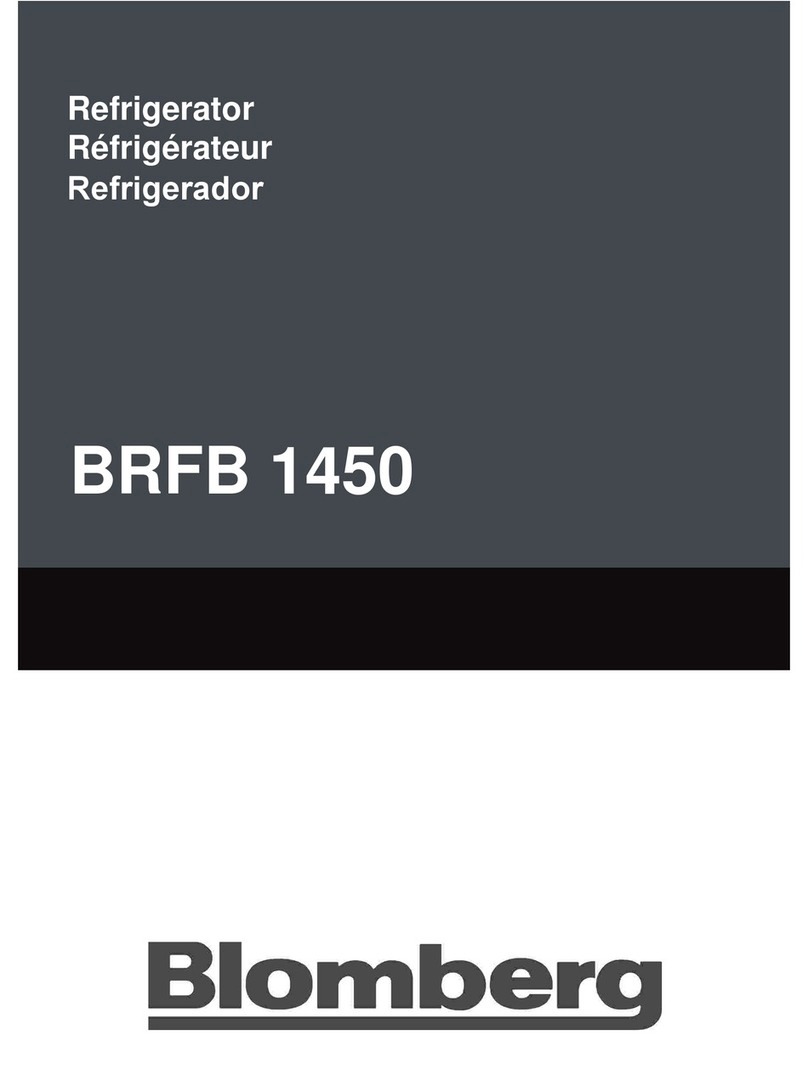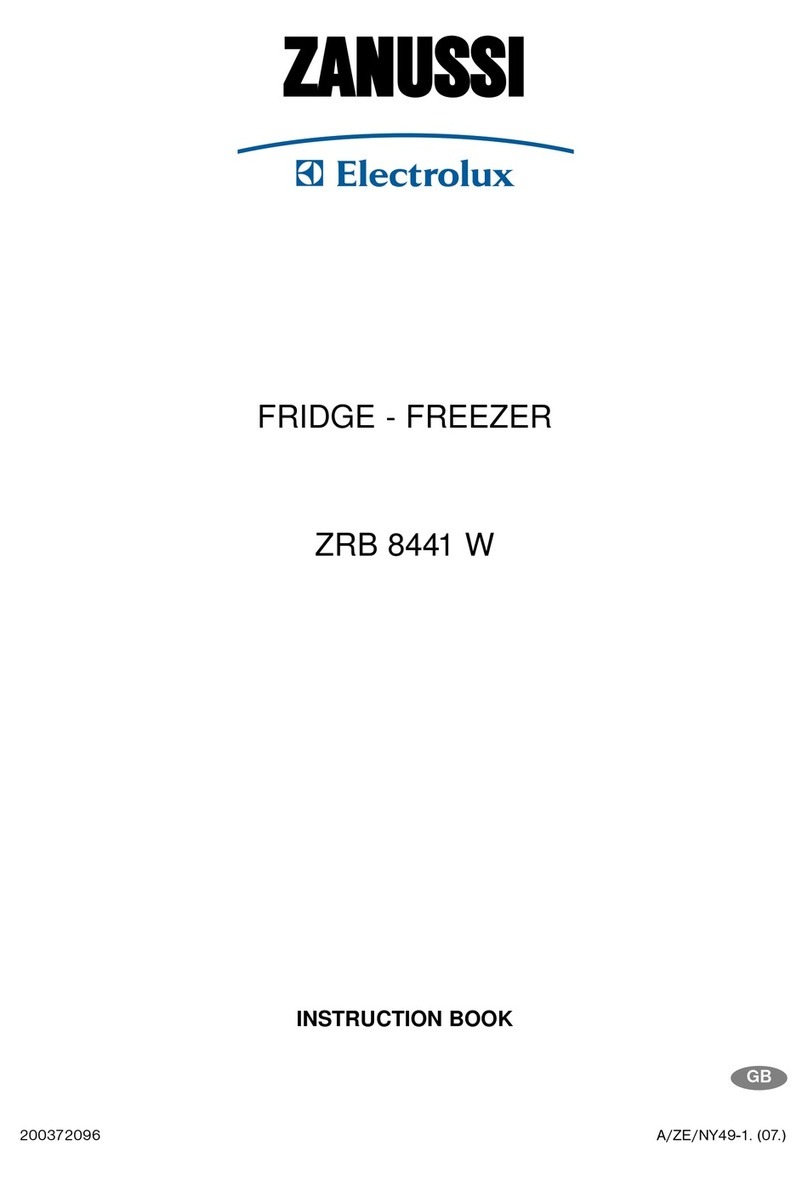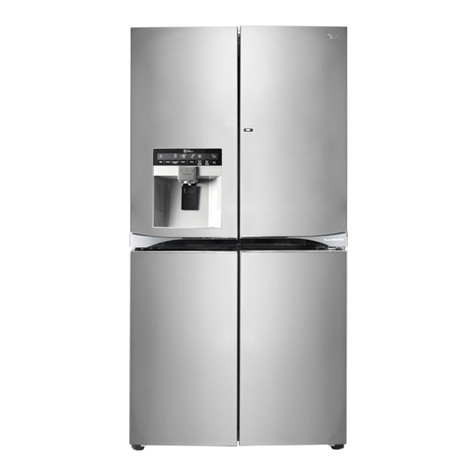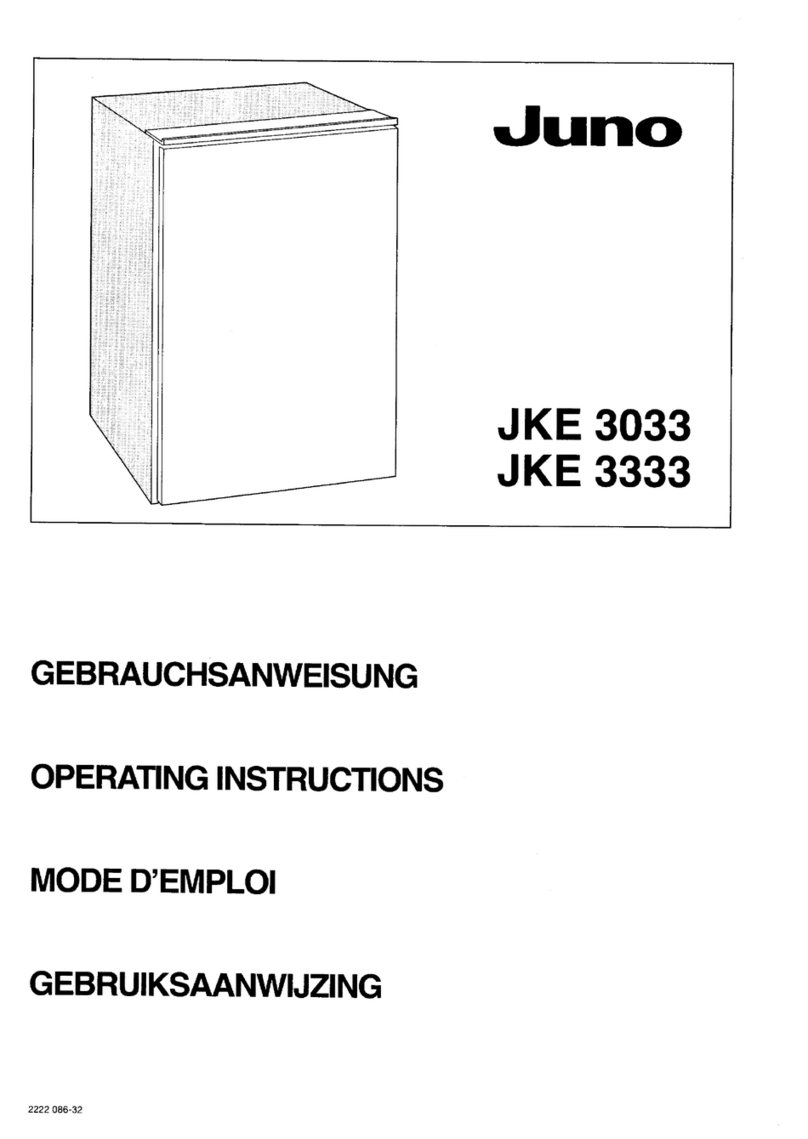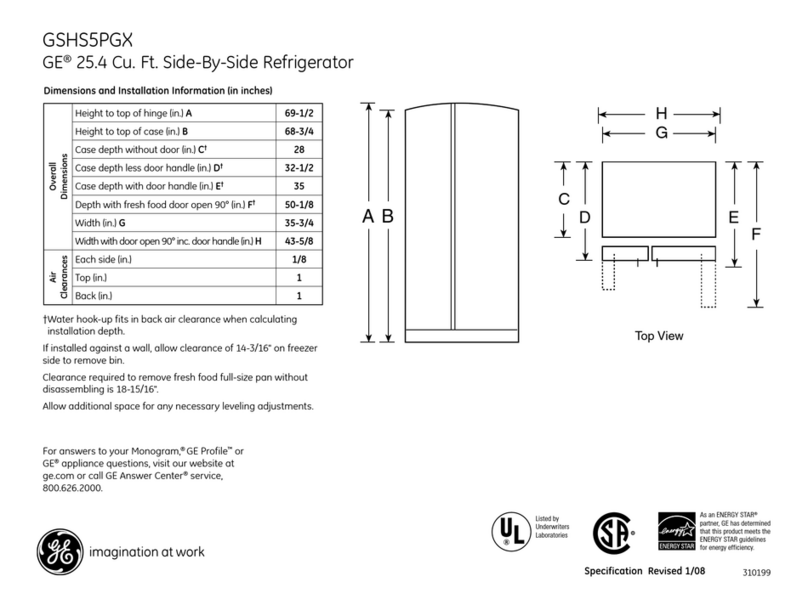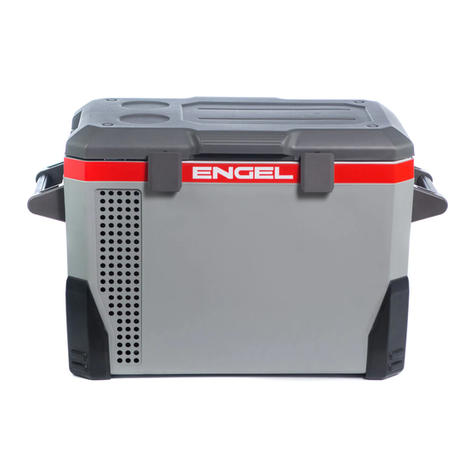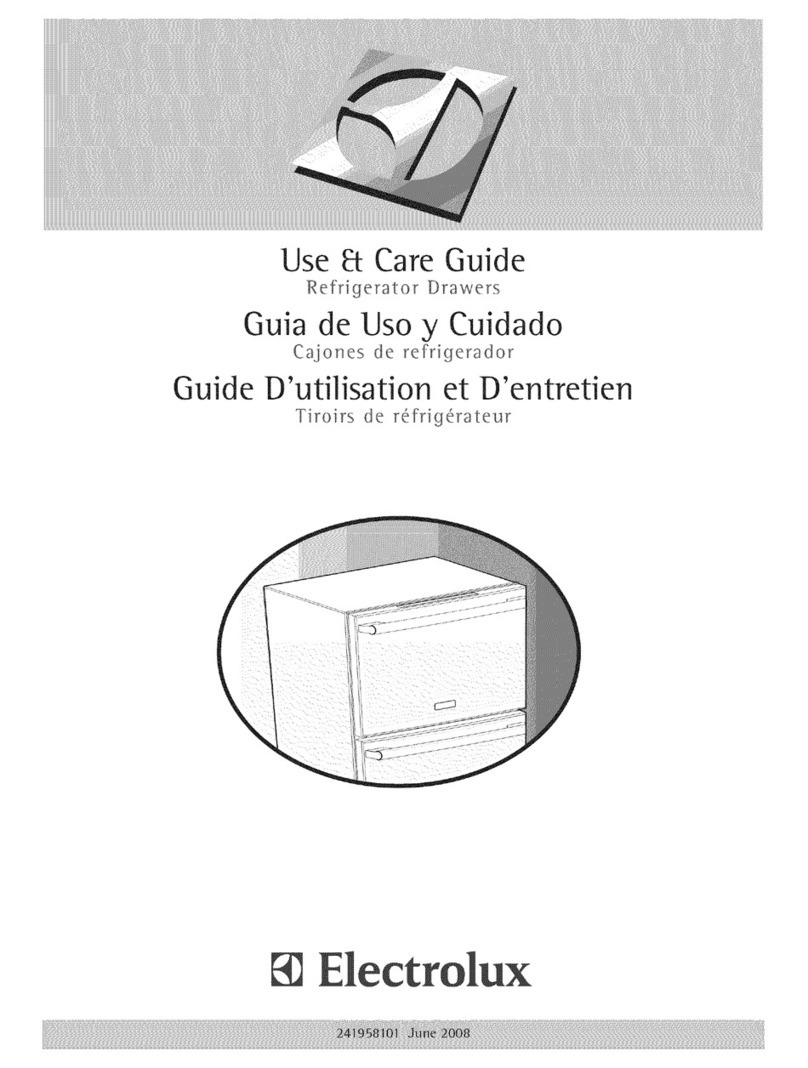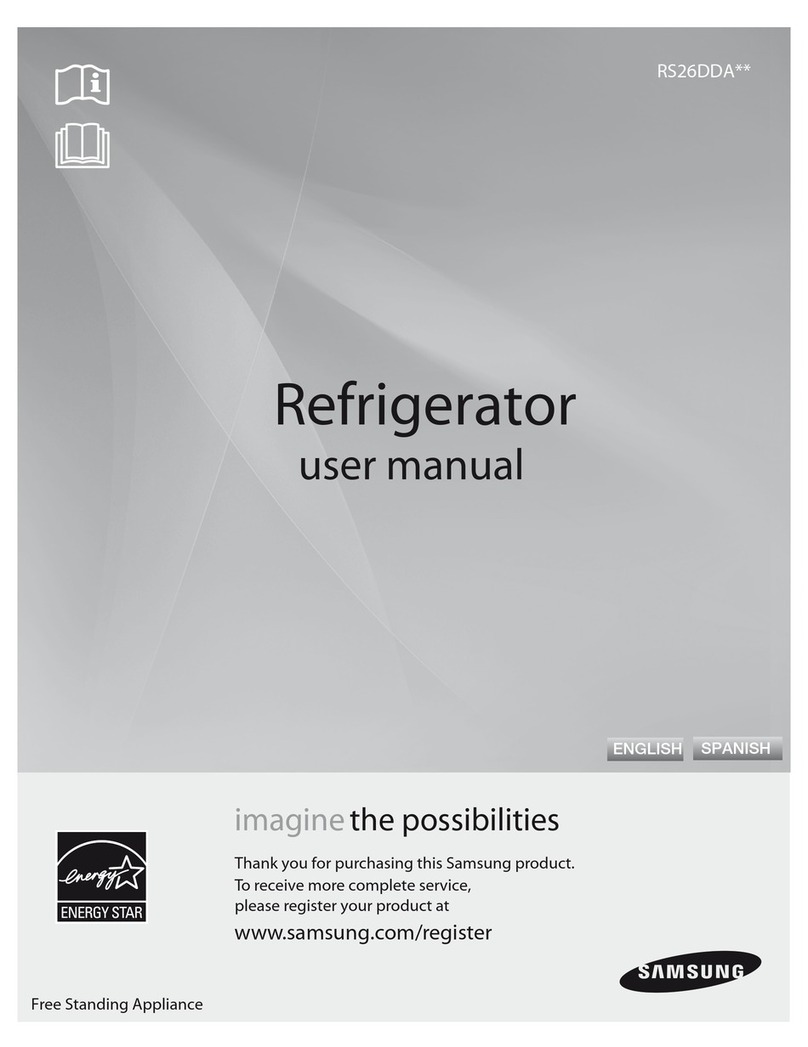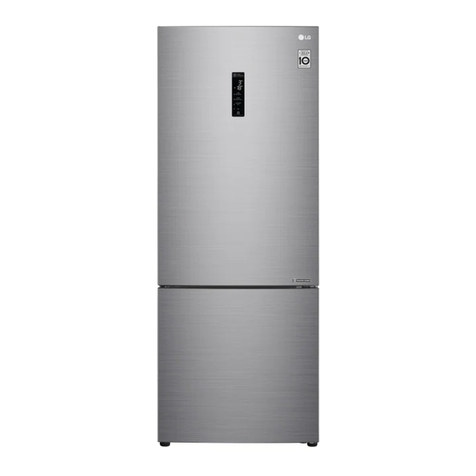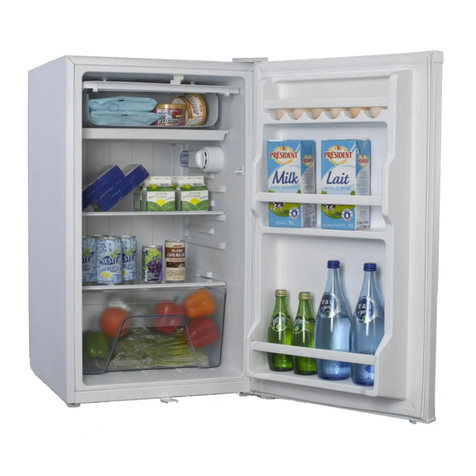Tappan pmn User manual

P/N 218947500 (9904)

2
Product Registration The information contained in this Owner's Guide will instruct you on how to
properlyoperateandcareforyourproduct. Pleasereadthroughtheinformation
contained in your literature pack to learn more about your new appliance.
Record Your Model and Serial Numbers
Record the Model No. and Serial No. of this refrigerator in the spaces provided
below. Thesenumbers are foundon the serialplate located onthe ceiling ofthe
refrigeratorcompartment.
Model No. __________________________________________________
Serial No. ___________________________________________________
Register Your Product
The self-addressed PRODUCT REGISTRATION CARD (shown left) should be filled
incompletely, signed and returned to the Frigidaire Company.
2 Product Registration
3 Important Safety Instructions
3 ForYour Safety
3 ChildSafety
3 ElectricalInformation
3 OtherPrecautions
4 FirstSteps
4 Location
4 Installation
4 Door Opening
4 Leveling
4 Cleaning
5 Energy Saving Ideas
5 Setting the Controls
5 Cool Down Period
5 RefrigeratorControl
5 FreezerControl
6 Fresh Food Storage
7-8 Automatic Ice and Water Dispenser
9-10 Care and Cleaning
10 Inside
10 Outside
10 ReplacingtheLightBulb
9-10 Vacation and Moving Tips
11 Removing the Handles and Doors
12-15 Avoid Service Checklist
15 Normal Operating Sounds
16 Warranty
17 Service Information Canada
18 Warranty (Canada)
Contents
© 1999 White Consolidated Industries, Inc.
Allrightsreserved.
Versión en español
Sidesea obtener una copia enespañol de este
Manual del Usuario, sírvase escribir la
direcciónqueseincluyeacontinuación.Solicite
la P/N 218947600.
Spanish Owner's Guides
Frigidaire Home Products
P.O. Box 212378
Augusta, GA 30917
ThisOwner's Guide provides specific
operatinginstructions foryourmodel.
Usetherefrigeratoronlyasinstructedin
thisOwner's Guide.
Proper Disposal of Your
Refrigerator/Freezer
Risk of child entrapment. Child
entrapment and suffocation are not
problems of the past.
Junked or abandoned
refrigeratorsarestilldangerous-evenif
theywillsitfor"justafewdays." Ifyou
aregettingridofyouroldrefrigerator,
pleasefollowinstructionsbelowtohelp
preventaccidents.
BEFORE YOU THROW
AWAY YOUR OLD
REFRIGERATOR OR
FREEZER:
• Takeoffdoors.
• Leaveshelves in
place,sochildren
maynot easily
climbinside.

3
Important Safety
Instructions For Your Safety
Donot store or usegasoline or otherflammable vapors andliquids in thevicinity
ofthis,oranyotherappliance. Readproductlabelsforflammabilityandotherwarnings.
• Destroycarton, plastic bags,and any exteriorwrapping material immediately
afterthe refrigerator isunpacked. Children shouldnever use theseitems for
play.Cartonscoveredwith rugs,bedspreads,plasticsheets,orstretchwrapmay
become airtight chambers that can quickly cause suffocation.
• Remove all staples from the carton. Staples can cause severe cuts, and ruin
finishesiftheycomeincontactwithotherappliancesorfurniture.
• An empty, discarded ice box, refrigerator, or freezer is a very dangerous
attraction to children. Remove door of any appliance that is not in use,
even if it is being discarded.
•Refrigerator must be plugged into its own 115 Volt, 60 Hz, AC only
electricaloutlet. The power cord of the appliance is equipped with a three-
prong grounding plug, for your protection against shock hazards. It must be
plugged directly into a properly grounded three-prong receptacle. The
receptacle must be installed in accordance with local codes and ordinances.
Consult a qualified electrician. DO NOT USE AN EXTENSION CORD OR AN
ADAPTER PLUG.
• If voltage varies by 10 percent or more, performance of your refrigerator may
beaffected.Operating the refrigerator with insufficientpower can damage the
compressor. Such damage is not covered under your warranty. If you suspect
your voltage is high or low, consult your power company for testing.
• Topreventtherefrigerator from being turnedoffaccidentally, do not plug the
unitintoanoutletcontrolled by a wall switch orpullcord.
• Do not pinch, knot, or bend the power cord in any manner.
Child Safety
Read all instructions before
using this refrigerator.
Avoid fire hazard or
electricshock.Donotuse anextension
cord or an adapter plug. Do not remove
any prong from power cord.
Electrical Information
These guidelines must be followed to ensure that safety mechanisms in the
design of this refrigerator will operate properly.
• Neverunplug the refrigerator by pulling on the power cord. Always grip the plug
firmly,and pullstraightoutfrom thereceptacle.
• Toavoid electrical shock, unplugthe refrigerator beforecleaning and before
replacingalightbulb. Note: TurningthecontroltoOFFturnsoffthecompressor,
butdoesnotdisconnectpowertothelightbulborotherelectricalcomponents.
• Do not operate the refrigerator in the presence of explosive fumes.
• Avoid contact with any moving parts of the automatic ice maker.
• Neverunplugtherefrigeratorbypullingonthepowercord.Alwaysgriptheplug
firmly,andpullstraightoutfromthereceptacle.
• Toavoidelectricalshock,unplug the refrigerator before cleaning and before
replacingalightbulb. Note: TurningthecontroltoOFFturnsoffthecompressor,
butdoesnotdisconnectpowertothelightbulborotherelectricalcomponents.
• Donotoperate the refrigerator inthepresence of explosive fumes.
• Avoid contact with any moving parts of the automatic ice maker.
Other Precautions

4
FirstSteps ThisOwner’sGuide provides specificoperating instructions for yourmodel. Use
refrigeratoronlyasinstructedinthisOwner’sGuide. Beforestartingrefrigerator,
follow these important first steps:
Location
Installrefrigerator:
• nearagroundedelectricaloutlet.DONOTuseanextensioncordoranadapterplug.
• outofdirectsunlightandawayfromrange,dishwasher,orotherheatsources,
ifpossible.
• onafloorthatislevelandstrongenoughtosupportafullyloadedrefrigerator.
• where a water supply is available for automatic ice maker.
Installation
• Do not install refrigerator where temperature will drop below 60°F (15°C), or
rise above 110°F (43°C). Compressor will not be able to maintain proper
temperatures.
• Ina recessed installation,allow an extra 1/2 inch (10-15 mm) on each side for
easeofinstallation.
• Ifthe hinge sideoftheunitwillbe placed againstawall,allowa1-3/4 inch (44
mm) space between wall and refrigerator to permit proper door swing.
Door Opening
For best use of drawers and freezer basket, refrigerator should be in a position
where both the refrigerator and freezer doors can be opened about 135°.
Leveling
• Refrigeratormust be leveled with all bottom corners resting firmly ona solid
floor.Adjustfrontrollerstolevelcabinetbothfront-to-rearandside-to-side.
Keepcabinetaslowaspossibleforstability.
Neveradjustcabinetrollerssofront
islowerthanrear.
•Toadjustfrontrollers: Openrefrigeratorandfreezer doors. Remove toe grill
bypullingitstraightout.Adjustrollersbyturningeachrolleradjustingboltwith
anadjustablewrench,asocketwrench,oranutdriveruntil refrigeratorislevel
andstable.Rearrollersarenotadjustable.
• Checkboth doorsto besure seals touch cabinet evenly on all four sides.
• Iffreezerdoorishigherthanrefrigeratordoor,raiserightcornerand/orlowerleft
corneruntildoorsalignacrosstopofcabinet.
• Ifrefrigeratordoorishigherthanfreezerdoor,raiseleftcornerand/orlowerright
corneruntildoorsalignacrosstopofcabinet.
•Toreplacetoe grill: Line up tabs with holes,and push grillstraight on.
Cleaning
• Wash the inside, all removable parts, and the outside with mild detergent and
warm water. Wipe dry. DO NOT USE HARSH CLEANERS ON THESE SURFACES.
• Do not use razor blades or other sharp instruments that can scratch appliance
surface, when removing adhesive labels. Any glue left from the tape or energy
label can be removed with a mixture of warm water and mild detergent, or touch
gluewith sticky sideof tape alreadyremoved.
• DO NOT REMOVE SERIAL PLATE.
AdjustingFrontRollers
ROLLER ADJUSTING
BOLT
ReplacingToeGrill

5
• Installtherefrigeratorinthemostcoolpartoftheroom,outofdirectsunlightand
awayfrom heatingductsorregisters.Do not place therefrigeratornextto heat-
producingappliancessuchasarange,ovenordishwasher.Ifthisisnotpossible,
asection of cabinetryoranaddedlayer of insulationbetweenthetwoappliances
willhelptherefrigeratoroperatemoreefficiently.
• Leveltherefrigeratorsothedoorsclosetightly.
• Referto this Owner'sGuideforthesuggestedrefrigerator settings.
• Periodiccleaningofthecondenserwillhelptherefrigeratorrunmoreefficiently.
See Outside in the "Care and Cleaning" section.
• Do not overcrowd the refrigerator or block cold air vents. Doing so causes the
refrigeratortorun longer and usemoreenergy. Shelves shouldnotbe lined with
aluminum foil, wax paper or paper toweling. Liners interfere with cold air
circulation, making the refrigerator less efficient, which could cause food
spoilage.
• Coverfoodsandwipecontainers drybeforeplacingthem intherefrigerator.This
cuts down on moisture build-up inside the unit.
• Organize the refrigerator to reduce door openings. Remove as many items as
needed at one time and close the door as soon as possible.
Setting the Controls Cool Down Period
Toensure safefoodstorage,allowthe refrigerator tooperatewiththedoors closed
for at least 8 to 12 hours before loading with food.
Refrigerator Control
• Therefrigeratorcontrolshouldbesetatthemidpointofthedialforatrialperiod
of 24 hours.
• After24hours, adjust the controlas needed. For coldertemperatures, turn the
dial a notch toward COLDEST. For warmer temperatures, turn the dial a notch
toward COLD. Adjust temperatures by one increment at a time.
Freezer Control
• Thefreezer control should besetatthemidpointofthe dial for atrialperiodof
24hours.
• After24hours, adjust the controlas needed. For coldertemperatures, turn the
dial a notch toward COLDEST. For warmer temperatures, turn the dial a notch
toward COLD. Adjust temperatures by one increment at a time.
Note: When first setting the controls or when changing a setting, wait 24 hours
forthe temperature to stabilizebefore making additional changes.
Turning the freezer control may change temperatures in both compartments. For
example,ifthefreezercontrolisturnedtoacoldersetting,therefrigeratorcontrol
may have to be adjusted to a warmer one. Turning the refrigerator control will
changeonly the refrigerator temperature.
IMPORTANT: If the freezer control is turned to OFF, cooling stops in both
compartments.
You may hear the "Frost Free" system working. A fan circulates air in the
refrigerator and freezer compartments. For good circulation and maintenance of
proper cooling temperatures, do not block cold air vents with food items. Water
draining into the defrost water pan and hissing sounds are normal during the
automatic"FrostFree"cycle.
Energy Saving Ideas
FreezerControl
RefrigeratorControl
FreezerControl

6
Fresh Food Storage Shelf Adjustment
Refrigeratorshelvesareeasilyadjustedtosuitindividualneeds.Beforeadjusting
shelves,removeallfood.Theshippingclipswhichstabilizetheshelvesforshipping
may be removed and discarded.
Toadjustthecantilevershelves
(shelvessupportedattherearoftherefrigerator),
liftthebackoftheshelf up and out. Replace shelf by insertinghooksatrearinto
slots.Lower and lock intoposition. Some models have
Spillfree
glassshelves,
whichcatchandholdaccidentalspills.
Door Storage
Doorbinsandshelvesareprovidedforconvenientstorageofjars, bottlesandcans.
Itemsusedoftenareavailableforquickselection.
Thedoor binscanbemoved tosuitindividualneeds. Removebinsbylifting straight
up.Place bins in the desiredposition and lower over thesupports.
The Dairy compartment is warmer than the general food storage section and is
intendedforshort term storageofcheese, spreads, or butter.
Crisper
TheCrisperdrawer,locatedunderthebottomrefrigeratorshelf,isforstoringfruits
and vegetables. Most produce should be washed in clear water and drained before
placinginthisdrawer. Items with strongodorsorhigh moisture should be wrapped
beforestoring.
The Humidity Control (some models) allows you to adjust the humidity within the
Crisperdrawer.Thiscanextendthelifeoffreshvegetableswhichkeepbestin high
humidity. Leafy vegetables, however, keep best when stored with the Humidity
Control set on HIGHER, or in a drawer without a Humidity Control. This keeps
incoming air to a minimum and maintains maximum moisture content.
Meat Keeper
The Meat Keeper is located at the bottom of the refrigerator. The temperature in
this compartment can be made colder than the rest of the refrigerator compart-
ment by sliding the Chilled Air Control knob within the COLDEST or COLD range.
Meat will be partially frozen and may be kept fresh longer than if stored on a
refrigeratorshelf.
BeforeplacingitemsintheMeatKeeper, follow these steps to keep the meatfresh:
1. Carefully handle meat with clean hands and always keep the compartment
clean.
2. Storemeatinitsoriginalwrapper.Ifnecessary,overwrapinplasticwraporfoil
topreventdrying. Wrap fish tightlyto prevent odor transfertoother foods.
3. Ifspoilageeveroccurs,disinfectthecompartmentwithliquidchlorinebleach
followinglabel directions. Thenrinsewithasolutionof baking sodaandwater.
Rinse with clear water and dry.
Remove Shipping Clips
FRESH FRUITS & VEGETABLES
LOWER
FRUITS
HIGHER
HUMIDITY CONTROL
VEGETABLES
Humidity Control
ChilledAirControl Freezer Basket
A slide-out wire basket (some models have two) hangs below the bottom freezer
shelf.This basket provides easy access to frozen food packages.
Tall Storage Compartment (some models)
Ashelf is attachedto the freezerwall just belowthe ice server.This allows for
convenientstorage of tall itemsplaced vertically between theice server and the
freezerwall.
TallStorage
Compartment

7
Automatic Ice and
Water Dispenser
Theiceandwaterdispenseronthefreezerdoorconvenientlydispenseschilledwater
andicecubes.
Tooperate the dispenser,slide the knob to the selection of your choice and press
aglass against the dispensingarm,as shown. Besure to hold theglass as far upas
possibleto catch all ice. To stop dispensing,pullglassawayfromdispensingarm.
Whendispensing ice, releasethedispensingarmbeforethe glass isfull,butdonot
removetheglassuntil the ice has completelydispensed.
Asmallheatedarea beneath the dispenser floor catches and evaporates small spills.
This drip tray is removable and dishwasher safe. Do not pour water or excess
cubes into this area because there is no drain.
Light
The dispenser has a light which can be turned on and off by sliding the knob to the
desiredposition. The lightalso turns on automatically whenice and/or water is
dispensed.Replace lightbulb withan appliance bulb of the same wattage.
How the Water Dispenser Works
The water tank is located behind the drawers in therefrigerator compartment. As
thewaterisdispensed,thetankisautomaticallyrefilled.Forproperoperationofthe
dispenser, the supply water pressure must fall between 30 psi and 120 psi.
Afterthe refrigerator is installed andtheplumbingconnectionsarecomplete,the
water tank should be filled by drawing one glass of water. It may take
about 1-1/2 minutes after depressing the dispenser arm before water works its
waythroughtheplumbingconnectionsandbeginsto fill this first glass. Drawand
discard7more glasses to be surethatthe tank and plumbing connectionsare rinsed
ofanyimpurities. The water delivery system has a built in shut off device that will
stop the water flow after 3 minutes of continuous use. Simply release the actuator
button to reset the dispensing mechanism.
To ensure fresh-tasting water,
plan to use the dispenser every day. If the water
dispenser has not been used for a week or more, draw and discard 7-8 glasses to
freshenthe tank supply.
How the Ice Dispenser Works
Theice maker andice storage binare located inthe top left corner of the freezer
compartment.Aftertherefrigeratorisinstalledproperlyandhascooledforseveral
hours,the ice makercan begin makingice. To begin ice production, lower the wire
signal arm to the "down" or ON position. As cubes are made, they are stored in the
storagebin.Withnousageitwilltakeapproximately2daystofillthebin.However,
thedispenser may beused after thefirst batch ofice is made. The ice maker turns
offautomatically whentheicestoragebinisfull.
Because of new plumbing connections, the first production of ice cubes may be
discolored or have an odd flavor. These should be discarded until the cubes made
arefreeofdiscolorationandtaste. Remember that water quality
determinesyour icequality. Itisbestto connect theicemakertowater that isnot
softened. Chemicals from a malfunctioning softener can damage the ice maker.
If ice maker is connected to soft water, ensure the softener is maintained and
workingproperly.
Tostoptheicemaker, lift the wire signal armuntilitclicksandlocks in the "up"
orOFFposition.
DispenserSelector
Pressglassagainstdispensingarm.

8
Do not use the ice
chute as a handle when removing
or replacing the ice storage bin.
Surfaces there may be sharp.
WARNING
Ice Dispenser Tips
1. Ice cubes stored too long may develop an odd flavor. Empty the container and
return it to the proper position. The ice maker will then produce more ice.
2. Occasionallyshake the container tokeep ice separated.
3. Ifthedispensing arm is pushed informore than 4 minutes,thedispenser motor
mayoverloadandstop.Theoverloadprotectorwillresetautomaticallyafter3
or4minutes.Ifalargequantityof iceisneeded atonetime,itisbestto remove
cubesdirectlyfromtheice storagebin.
4. Certain sounds are normal when the ice maker is operating. They are:
• Motor operation
• Ice being loosened from the tray
• Icedropping into the storage bin
• Running water
• Water valve opening or closing
For more information on these operations, see "Normal Operating Sounds."
5. Stop the ice maker when cleaning the freezer or for long vacations.
6. Iftheicemakeristobeturnedoffforalongperiodoftime,turnthewatersupply
valvetotheclosedposition.
Automatic Ice and
Water Dispenser
(continued)
Cleaning the Ice Dispenser
Cleanthedispenserandicestoragebinatregularintervals,particularlybeforeyou
takea vacation or move, oriftheicedispensersticks.
1. Stopiceproduction by lifting thewiresignal arm to the "up"orOFF position.
2. Removeicestorage bin by lifting upandout. Empty and carefullycleanthe bin
with milddetergent.Do not submerge thebin while cleaning. Rinsewithclear
water. Do not use harsh or abrasive cleaners. Allow ice bin to dry completely
beforereplacinginthefreezer.
3. Remove ice chips and clean the shelf and chute that supports the ice storage
bin.
4. Replace the ice storage bin. Lower the wire signal arm on the ice maker to the
"down" or ON position and the ice maker will resume production.
IMPORTANT: When removing or replacing the ice bin, do not rotate the auger
intheicebin.Ifthe augerisaccidentallyturned,youmustrealigntheauger by
turningitin90°turnsuntiltheicebinfitsintoplacewiththedrivemechanism.
Forfurtherinstruction,seethelabel ontheicebucket.
Remove and empty the ice storage bin if:
1. An extended power failure (one hour or longer) causes ice cubes in the ice
storage bin to melt and freeze together and jam the dispenser mechanism.
2. Theicedispenserisnotusedfrequently.Icecubeswillfreezetogetherinthebin
and jam the dispenser mechanism. Remove the ice storage bin and shake to
loosenthecubes.
NEVER use an ice pick or similar sharp instrument to break up the ice. This could
damage the ice storage bin and dispenser mechanism.
Repositioning the Auger
AUGER
DRIVER
MECHANISM
DO NOT PUT FINGERS UP ICE CHUTE.
SURFACES THERE MAY BE SHARP.

9
Care and Cleaning Keepyourrefrigeratorandfreezercleantopreventodorbuild-up.Wipeup anyspills
immediately and clean both sections at least twice a year. Never use metallic
scouringpads,brushes,abrasivecleanersorstrongalkalinesolutionsonanysurface.
Do not wash any removable parts in a dishwasher.
Always unplug the power cord from the wall outlet before cleaning.
NOTE: Turning the control to OFF does not disconnect power to the controls, light
bulb,orotherelectricalcomponents.
Inside
Washinsidesurfacesoftherefrigeratorandfreezerwithasolutionof2tablespoons
baking soda in 1 quart warm water. Rinse and dry thoroughly.
Be sure to wring
excesswaterout of sponge or cloth before cleaning around the controls, light bulb,
oranyelectricalparts.
Washremovable parts suchas shelves anddrawers with bakingsoda solution ormild
detergent and warm water. DO NOT USE HARSH CLEANERS ON THESE SURFACES.
Rinse and dry thoroughly. Clean the door gaskets with mild suds, rinse with clear
water and wipe dry. Do not use razor blades or other sharp instruments which can
scratchthe appliance surface when removingadhesivelabels.Anyglueleftfrom the
tape or energy label can be removed with a mixture of warm water and mild
detergent,or, touch the glue with the sticky side of tape already removed.DO NOT
REMOVE THE SERIAL PLATE.
Outside
Washthe cabinet andhandles with warmwater and mild liquid detergent. Rinsewell
and wipe dry with a clean soft cloth. Do not use commercial household cleaners,
ammonia, or alcohol to clean handles.
Removeany dust or dirt fromthe front of the toe grill using a vacuum cleaner with
itsdustingtoolattachment.Removethetoegrillbypullingitstraightout.Whilethe
grill is removed, vacuum the backside of the grill and wipe with a sudsy cloth or
sponge. Periodically clean the condenser (black tubes and wires beneath the
refrigerator,behindthetoegrill).Donotallowlintordusttoaccumulateonthecoils.
Insert a long handled brush or vacuum attachment between the two coils to bring
thelintforward.Toreplacethetoegrill,lineuptabswithholesandpushgrillstraight
on. Use caution when cleaning in the area of the coils. Surfaces
there may be sharp.
The air vents on the lower access panel at the rear of the refrigerator should be
cleanedperiodically.Cleantheventsbyusingavacuumcleanerwithits dustingtool
attachment. When moving the refrigerator, pull straight out. Do not shift the
refrigeratorfromsidetosideasthismaytearorgougethefloorcovering.Becareful
not to move the refrigerator beyond plumbing connections.
Damp objects stick to cold
metalsurfaces.Donottouch refrigerated
surfaces with wet or damp hands.
To avoid damage and help
the refrigerator run as efficiently as
possible, clean the condenser and air
ventsperiodically.
Air Vents on Lower Access Panel
Replacing the Light Bulb
To replace the light bulb in either compartment:
1. Unplugtherefrigerator.
2. Wearglovesasprotection against possible broken glass.
3. Replace old bulb with an appliance bulb of the same wattage.
4. Remember to plug the refrigerator back in.
Vacation and Moving Tips
Short vacations:
• Leaverefrigeratoroperatingduring vacations of 3 weeksorless.
• Useupallperishableitemsinrefrigeratorsection.
• Wrap and store other items in the freezer.
• Turn off automatic ice maker, even if you will be gone just a few days.

10
Care and Cleaning
(continued)
Long vacations:
• Remove all food and ice if you will be gone 1 month or more.
• Turn controls to OFF and disconnect power.
• Turn off automatic ice maker and turn water supply valve to the closed
position.
• Clean interior thoroughly. Leave both doors open to prevent odor and mold
build-up.Blockopenifnecessary.
Moving: Whenmovingrefrigerator,followtheseguidelinestopreventdamage:
• Remove all food and other items from both the refrigerator and freezer
•compartments.
• Emptyicestoragebin.
• Ifahandtruck is used in moving, load refrigeratorfromtheside.
• Turnrollersasfarupaspossible.Thiswillprotectthemduringslidingormoving.
• Cabinet should be well padded and handled with care. DO NOT DROP.
IMPORTANT
OnceyourrefrigeratorIceandWaterdispensing system has been filled with water,
itis importantthat therefrigeratorremaininan environmentthatstaysabovethe
freezingmark.
Iftherefrigeratorisgoingtobestoredinanenvironmentthatwillfallbelowfreezing,
or will see freezing temperatures during a move, the water in the Ice and Water
systemmust be drained completely. Failure to do so couldresult in damage to the
Iceand Watersystem.Thisdamagecould resultinwaterleakswhenthe refrigerator
isputbackinservice.
Itwouldbeadvisabletocontactaservicerepresentative toperformthisoperation.

11
Removing the Handles
and Doors
If it is necessary to move the refrigerator through narrow doorways,
follow these steps to remove the handles and/or refrigerator and freezer
doors.
To Remove Handles
Full-lengthTrim:
1. Usingaputtyknife, carefullyslidethe cornerofthebladeunderthetrim.Slide
bladedown until you find the trim lock. Carefully maneuver the blade against
the trim lock from the side as shown.
Note: Pressing down on the trim lock
fromabovewillnotreleaseit.
2. Carefullypushtheputtyknifefirmlyagainstthe trimlockandtwistgently.The
trimlockwillsnapfreefrom thedoor.(Eachtrimpiece willhavetwotrimlocks.)
3. Grasp trim and pull up away from handle using a slight side-to-side motion.
4. Remove screws attaching handle to door.
5. Repeat these steps for each handle end. Keep screws and trim pieces.
6. Toreplacehandles, line up handle with screw holes, insert screws and tighten.
Slideupperand lower trim piecesbackon handle ends, andsnap trim locks back
intoholesondoorfront.
To Remove Doors
Before removing the doors, be sure the freezer control is turned to OFF. Remove
allfood from thedoors and unplugthe refrigerator. Removethe toe grill.
Tracearound the hinges with a soft leadpencil.Thiswillmakeiteasiertorealign
the doors when they are replaced. Completely remove one door before starting
removalof the other.
Freezer Door:
1. Removethe toe grill. (See Outside in the"Care and Cleaning" section.)
2. Remove the wiring cover located over the lower hinge of the freezer door. The
coveris held in placebyasinglescrew.(Figure 1)
3.Todisconnectwiringharnessplug (connector),position yourself to be able to
place your thumbs on the flat sides of each connector piece. Bend both parts
back and forth. Then with a firm grasp, pull the two pieces apart as shown.
4. To disconnect water line, hold water line elbow and push in on gray collar,
forcing elbow down, off from tube that runs into door.
5. Placeastrip of tape along thedoorbottom, over the lower hingeandup the side
of the door. This will hold the hinge in place when the door is removed.
6. Remove the top bolt of the lower hinge. Loosen, but DO NOT REMOVE, the
bottom bolt of the lower hinge.
7. Remove top hinge cover by lifting back of cover and sliding forward. Remove
hinge screws from hingebracket with a counter-clockwisemotion.Note: Hinge
has minimal spring tension. Hold bracket when removing last screw. DO NOT
remove hinge bracket from door.
8. Carefullyliftthe door up and offtheloosened lower hinge bolt. (Figure2)
Refrigerator Door:
1. Remove top hinge cover by lifting back of cover and sliding forward. Remove
hinge screws from hingebracket with a counter-clockwisemotion.Note: Hinge
has minimal spring tension. Hold bracket when removing last screw. DO NOT
remove hinge bracket from door.
2. Remove the top bolt of the lower hinge. Loosen, but DO NOT REMOVE, the
bottom bolt of the lower hinge.
3. Carefullylift the doorup and off theloosened lower hingebolt.
Storethedoorsinasafeplaceuntiltherefrigeratorismovedtothedesiredlocation.
Keepallhardwareforreinstallation.
To Reinstall Doors
Toreinstallthedoors,reversetheinstructionsused toremovethe doors.Note: To
reinstallwaterline,pushelbowup, onto door tube, until collar touchestubeink
mark as shown left.
C05I0122
Removing handles and trim
C05I0124
Figure1
WATER LINE NUT
Figure2

12
RUNNING OF REFRIGERATOR
OCCURRENCE
Refrigerator compressor does not run.
SOLUTION
Avoid Service Checklist Beforecallingforservice,reviewthislist.Itmaysaveyoutimeandexpense.Thislist
includescommon occurrences that are not the result of defectiveworkmanship or
materialsinthisappliance.
Freezercontrol is off.Set freezer control.See Setting theControls.
Refrigeratorisindefrostcycle.Thisisnormalforafullyautomaticdefrostingrefrigerator.Thedefrost
cycleoccursperiodically,lastingabout20minutes.
Plugat wall outletis disconnected. Makesure plug istightly pushed intooutlet.
House fuse has blown or circuit breaker has tripped. Check and/or replace fuse with a 15 amp time-
delayfuse.Resetcircuitbreaker.
Power outage. Check house lights. Call local electric company.
Roomoroutsideweather is hot. It isnormalforthe refrigerator to worklongerunderthese conditions.
Refrigerator has recently been disconnected for a period of time. It takes about 8-12 hours for the
refrigeratorto cool down completely.
Automatic ice maker is operating. Ice maker operation causes refrigerator to run slightly more.
Doorsare opened toofrequently or toolong. Warm airentering the refrigeratorcauses it to run more.
Open doors less often.
Refrigerator or freezer door may be slightly open. Make sure refrigerator is level. Keep food and
containers from blocking door. See Occurrence section OPENING/CLOSING OF DOORS/DRAWERS.
Refrigeratorcontrol(foundinrefrigeratorsection)issettoocold.Setrefrigeratorcontroltoawarmer
settinguntil refrigeratortemperatureis satisfactory.Allow24hoursforthetemperaturetostabilize.
Refrigeratororfreezergasketisdirty,worn,cracked, or poorly fitted. Clean or change gasket. Leaks
indoor seal willcause refrigerator to run longer inorder to maintaindesired temperatures.
Thermostatiskeepingrefrigeratorataconstanttemperature. This is normal. Refrigerator goes on and
off to keep temperature constant.
Freezer control is set too cold. Set freezer control to a warmer setting until freezer temperature is
satisfactory.Allow24hoursforthetemperaturetostabilize.Then,ifrefrigerator temperature is not
right,setrefrigeratorcontroltoacoldersetting.
Refrigeratorcontrolis set too cold.Set refrigerator control toa warmer setting. Allow24 hours for
temperaturestostabilize.
Refrigeratorcontrolissettoocold.Seesolution above.
Meat should be stored at a temperature just below the freezing point of water (32°F, 0°C) for
maximumfresh storage time. It is normal forice crystals to form due to the moisture content of meat.
ChilledAir Control settoo cold. Adjust Chilled Air Control to a lowersetting.
Doors are opened too frequently or too long. Warm air enters refrigerator whenever door is opened.
Open door less often.
Door is open slightly. See Occurrence section OPENING/CLOSING OF DOORS/DRAWERS.
Condenser is dirty. Clean condenser. See "Outside" in Care and Cleaning.
Refrigerator runs too much or too
long.
Refrigerator compressor goes on and
offfrequently.
Temperature in freezer is too cold and
refrigerator temperature is
satisfactory.
Temperature in refrigerator is too cold
andfreezer temperature is satisfactory.
Food stored in drawers freezes.
Food stored in Meat Keeper (some
models) freezes.
Temperature in freezer or
refrigerator is too warm.
TEMPERATURES ARE TOO COLD
TEMPERATURES ARE TOO WARM

13
SOLUTION
OCCURRENCE
WATER/MOISTURE/FROST INSIDE REFRIGERATOR
Moisture collects on inside of refrigerator
walls.
Water collects on bottom side of drawer
cover.
Water collects in bottom of drawer.
Moisture forms on outside of refrigerator
or between doors.
Ice maker is not making any ice.
WATER/MOISTURE/FROST OUTSIDE REFRIGERATOR
AUTOMATIC ICE MAKER (some models)
Ice maker is not making enough ice.
Ice maker will not stop making ice.
Ice maker is not separating the cubes.
Ice has bad odor and taste.
Freezercontrolis set too warm. Set freezercontrolto a colder settinguntilfreezer temperature is
satisfactory. Allow24hoursforthetemperaturetostabilize.Then,if refrigeratortemperatureisnot
right,setrefrigeratorcontrolto awarmersetting.
Refrigeratorcontrol issettoowarm.Setrefrigeratorcontrol toacolder setting.Allow24hoursforthe
temperaturetostabilize.
ChilledAirControlissettoowarm.AdjustChilledAirControlto acoldersetting.
Weatherishotandhumid,which increases rate of frost buildup andinternalsweating.Thisisnormal.
Door is slightly open. See Occurrence section OPENING/CLOSING OF DOORS/DRAWERS.
Door is opened too often or too long. Open door less often.
Vegetablescontain and give offmoisture. It is notunusual to havemoisture on the bottomside of the
cover.
Washed vegetables and fruits drain while in the drawer. Dry items before putting them into drawer.
Watercollecting in bottomof drawer is normal.
Weather is humid. This is normal in humid weather. When humidity is lower, the moisture should
disappear.
Dooris slightly open, causing cold air from inside refrigerator to meet warm air from outside. See
Occurrence section OPENING/CLOSING OF DOORS/DRAWERS.
Ice maker wire signal arm is in "up" or OFF position. Move wire signal arm to "down" or ON position.
Householdwater line valve is notopen. Turn on household waterline valve.
Freezer is not cold enough. See Occurrence section TEMPERATURES ARE TOO WARM.
Saddlevalveoncoldwaterpipe is clogged or restricted by foreign material.Turnoffhouseholdwater
linevalve.Remove, clean orreplacevalve.
Ice maker is producing less ice than you expect. Ice maker should produce approximately
2-1/2 to 4 pounds of ice every 24 hours.
Freezer is not cold enough. See Occurrence section TEMPERATURES ARE TOO WARM.
Householdwater line valve is not completely open. Turn on household water line valve.
Ice maker wire arm is being held down by some item in freezer. Move item, and release arm. Remove
any ice cubes frozen together over arm.
Ice cubes are not being used frequently enough. Remove and shake ice bucket to separate cubes.
Icehas pickedupodoror flavorfromstrongfoodstoredinrefrigerator orfreezer.Coverfoodstightly.
Discardstale ice.Icemakerwillproducefreshsupply.
Waterrunning to icemaker has poor taste or odor. Add filter toice maker. Consult a water purifying
company.
Temperature in freezer is too warm.
Temperature in the refrigerator is too
warm and the freezer temperature is
satisfactory.
Temperature in Meat Keeper (some
models) is too warm.
TEMPERATURES ARE TOO WARM (continued)

14
SOLUTION
OCCURRENCE
ICE DISPENSER Icestoragebinisempty.Whenthe first supply of ice is dropped into bin, dispenser should operate.
Freezertemperatureissettoowarm.Turnfreezercontrol to a higher setting so that ice cubes will
be made. When first supply of ice is made, dispenser should operate.
Householdwaterlinevalveisnotopen. Openhouseholdwater line valve, and allow sufficient time
for ice to be made. When ice is made, dispenser should operate.
Freezerdoorisnotclosed. Besure freezer door is closed.
Icedispensing arm hasbeen held infor more than4-5 minutes. Motoris overloaded. Motoroverload
protectorwillresetinapproximately3minutes. Ice can then be dispensed.
Ice has melted and frozen around auger due to infrequent use, temperature fluctuations, and/or
power outages. Removeice storage bin, thaw, and empty the contents. Clean bin, wipe dry and
replace in proper position. When new ice is made, dispenser should operate.
Ice cubes are jammed between ice maker arm and back of bin. Remove ice cubes that are jamming
dispenser.
Ice cubes are frozen together. Use the dispenser often so that cubes do not freeze together.
Householdwaterlinevalveisnotopen. Openhouseholdwater line valve. See Occurrence "Ice maker
isnot making any ice."
Freezerdoorisnotclosed.Be sure freezer door is closed.
Water has been in the tank for a period of time. Draw and discard 7-8 glasses of water to freshen
thesupply. Draw and discard anadditional 3-6 glassesto completely rinseout tank.
Unitnotproperlyconnectedtocoldwaterline.Connectunit to cold water line that supplies water
tokitchen faucet.
Tubingusedinthehouseholdwatersupplyandinstallationof unit may affect water taste and odor.
Forbestresults,usecoppertubing for water connection.
Water has a high mineral content. Contact water treatment plant for help.
Have someone turn up the cut-off and cut-on pressure on the water pump system.
Interior needs to be cleaned. Clean interior with sponge, warm water, and baking soda.
Foodwith strongodorisin refrigerator.Coverfoodtightly.
Doorisnotdesigned to swing shut automatically. Closedoorsecurely.
Doorwas closed toohard, causing otherdoor to open slightly. Close both doors gently.
Refrigeratorisnotlevel.Itrocksonthefloorwhenitismovedslightly.Besurefloorislevelandsolid,
andcanadequatelysupportrefrigerator.Adjustrollersas needed.
Floorisunevenorweak.Refrigeratorrocksonthefloorwhenitismovedslightly.Besurefloorislevel
andcanadequatelysupportrefrigerator.Contactcarpentertocorrectsaggingor sloping floor.
Refrigeratoris touching thewall or cabinets. Be sure floor is level,and can adequately support
refrigerator.Contactcarpentertocorrect saggingorslopingfloor.
Food is touching shelf on top of drawer. Keep less food in drawer.
Trackthat drawersslidesonisdirty. Cleandrawer,rollers,andtrack.
Dispenser will not dispense ice.
Ice dispenser is jammed.
Dispenser will not dispense water.
Water has an odd taste and/or odor.
Water pressure is extremely low.
ODORS IN REFRIGERATOR
Door(s) will not close.
Drawers are difficult to move.
WATER DISPENSER
OPENING/CLOSING OF DOORS/DRAWERS

15
OCCURRENCE SOLUTION
LIGHT BULB IS NOT ON
Lightswitchis stuck. Lightswitchislocatedon interior doorframenexttothetemperature control
in each compartment. Push in plunger to release.
No electric current is reaching refrigerator. See Occurrence section
RUNNING OF REFRIGERATOR.
Light bulb is burned out. Replace bulb.
Normal Operating
Sounds

16
TAPPAN REFRIGERATOR WARRANTY
Your Tappan product is protected by this warranty
FRIGIDAIRE, THROUGH ITS
AUTHORIZED SERVICERS, WILL:
Pay all costs for repairing or replacing any parts of this
appliance which prove to be defective in materials or
workmanship.
Repair or replace any parts in the Sealed Refrigeration System
(compressor, condenser, evaporator, drier and tubing) which
prove to be defective in materials or workmanship, and
provide the labor to install such part.
All of the provisions of the full and limited warranties above
and the exclusions listed below apply.
THE CONSUMER WILL BE
RESPONSIBLE FOR:
Costs of service calls that are listed under NORMAL
RESPONSIBILITIES OF THE CONSUMER.*
Diagnostic costs and any removal, transportation and
reinstallation costs which are required because of
service. Costs for labor, parts and transportation
other than with respect to the Sealed Refrigeration
System.
Costs of the technician's travel to the home and any
costsfor pick upand delivery oftheappliance required
because of service.
FULL ONE-YEAR
WARRANTY
LIMITED 2ND - 5TH
YEAR WARRANTY
(Sealed System)
LIMITED
WARRANTY
(Applicable to the
State of Alaska)
WARRANTY
PERIOD
One year from original
purchase date.
Second through fifth years
from original purchase
date.
Time periods listed above.
This warranty applies only to products in ordinary household use, and the consumer is responsible for the
items listed below:
1. Proper use of the appliance in accordance with instructions provided with the product.
2. Proper installation by an authorized servicer in accordance with instructions provided with the appliance and in
accordance with all local plumbing, electrical and/or gas codes.
3. Proper connection to a grounded power supply of sufficient voltage, replacement of blown fuses, repair of loose
connections or defects in house wiring.
4. Expenses for making the appliance accessible for servicing, such as removal of trim, cupboards, shelves, etc., which
are not a part of the appliance when it was shipped from the factory.
5. Damages to finish after installation.
6. Replacement of light bulbs and/or fluorescent tubes (on models with these features).
This warranty does not cover the following:
1. CONSEQUENTIAL OR INCIDENTAL DAMAGES SUCH AS PROPERTY DAMAGE AND INCIDENTAL EXPENSES RESULTING
FROM ANY BREACH OF THIS WRITTEN OR ANY IMPLIED WARRANTY.
Note: Some states do not allow the exclusion or limitation of incidental or consequential damages, so this limitation
or exclusion may not apply to you.
2. Service calls which do not involve malfunction or defects in workmanship or material, or for appliances not in ordinary
household use. The consumer shall pay for such service calls.
3. Damages caused by services performed by servicers other than Frigidaire or its authorized servicers; use of parts other
than genuine Frigidaire Home Products parts; obtained from persons other than such servicers; or external causes
such as abuse, misuse, inadequate power supply or acts of God.
4. Products with original serial numbers that have been removed or altered and cannot be readily determined.
Keep your bill of sale, delivery slip, or some other appropriate payment record. The date on the bill establishes the warranty
period should service be required. If service is performed, it is in your best interest to obtain and keep all receipts. This
written warranty gives you specific legal rights. You may also have other rights that vary from state to state. Service under
this warranty must be obtained by contacting Frigidaire Home Products:
800•944•9044
Frigidaire Home Products
P.O.Box 212378
Augusta, GA 30917
Product features or specifications as described or illustrated are subject to change without notice. All warranties are made
by White Consolidated Industries, Inc. This warranty applies only in the 50 states of the U.S.A. and Puerto Rico.
*NORMAL
RESPONSIBILITIES
OF THE CON-
SUMER
EXCLUSIONS
IF YOU NEED
SERVICE
Your appliance is warranted by White Consolidated Industries, Inc. We authorize no person to change or add to any of our obligations under
this warranty. WCI has authorized Frigidaire Home Products and its authorized servicers to perform services covered by this warranty. Our
obligations for service and parts under this warranty must be performed by Frigidaire or an authorized Frigidaire servicer.

17
To avoid unnecessary cost and inconvenience, make a few simple checks before
calling for service. Common occurrences and their solutions can be found in the
Avoid Service Checklist. Be sure you have followed the instructions in this
manual.
If you are unable to locate the cause of a problem, call for service. Insist on
factory service by an authorized FRIGIDAIRE PARTS AND SERVICE depot.
FRIGIDAIRE PARTS AND SERVICE
All Frigidaire appliances are backed by FRIGIDAIRE PARTS AND SERVICE, one
of Canada's largest parts and service networks.
The Frigidaire reputation means you can enjoy complete professional service
from one of our hundreds of trained technicians across the country.
FRIGIDAIRE PARTS AND SERVICE
7075 Ordan Drive
Mississauga,Ontario
L5T 1K6
Place the name, address and telephone number of your service depot in the
spaces below.
Product and feature specifications as described or illustrated are subject
to change without notice.
Service Information
(Canada)

18
WARRANTY IN CANADA
REFRIGERATORS (FROST FREE)
Forservice underthiswarranty,contactyour local dealer/
retailer, authorized FRIGIDAIRE PARTS AND SERVICE de-
pot,or:
FRIGIDAIRE HOME PRODUCTS
PARTS AND SERVICE
7075 Ordan Drive
Mississauga,Ontario
L5T 1K6
Tel: (905) 565-9200
Fax: (905) 565-0937
WARRANTOR WILL THROUGH ITS AUTHORIZED SERVICE
DEPOT:
Paycosttorepairorreplaceanydefectiveparts(including
service and labour charge). Excludes original and
replacementPureSource™ Ice & Water Filtercartridges(if
equipped). Originalandreplacementcartridgesarewarranted
for30days(partsonly).
Paycost(includingserviceandlabourcharge)torepair or
replacedefective parts ofthesealedrefrigerationsystem
consisting of the compressor, evaporator, condenser,
interconnectingtubingdrierandrefrigerationcharge.
WARRANTOR:
FrigidaireHome Products
7075 Ordan Drive
Mississauga,Ontario
L5T 1K6
WARRANTY PERIOD:
Forthefirstyear after purchase bytheoriginal consumer/
owner:
Forthesecond,third,fourth,fifth,sixth,seventh,eighth,
ninthandtenthyearafterpurchasebytheoriginalconsumer/
owner:
WARRANTY APPLIES TO:
a) Productspurchased andinstalledin Canada for personalsingle family household use.
b) Defectsresultingorarisingout ofthemanufacturingprocess.
c) Productsbearinglegiblemanufacturer’smodeland serial numbers.
d) Replacementparts only fortheremainder of the originalwarranty.
WARRANTY DOES NOT APPLY TO:
a) Transportationdamage.
b) Supplyand replacement of porcelain, fuses, glass and light bulbs.
c) Parts and service supplied or obtained from other than FRIGIDAIRE PARTS AND SERVICE or FRIGIDAIRE PARTS SERVICE
authorizeddepots.
d) Properinstallation,controlsettingandcareoffinish.
CONSUMER/OWNER RESPONSIBILITY:
a) To provide proof of the original date of purchase by means of a bill of sale or payment.
b) Supplyand replacement of porcelain, fuses, glass and light bulbs.
c) To ensure proper power supply and connection of the appliance to same.
d) Properinstallation,controlsettingandcareoffinish.
Thiswarrantyisinadditiontoanystatutorywarranties containedinanyapplicablelegislation. Thetermsandconditions of
thiswarrantyarenotintendedto excludeorlimityourrightsunderthosestatutes. Thewarrantorhoweverreservestheright
tochargetransportationandtravelling costsfordistancesin excessof48 kilometres(30miles)fromthenearestFRIGIDAIRE
PARTS AND SERVICE authorized service depot.
Thiswarranty plus the statutory warrantiesmentionedaretheonlywarrantiesgivento the consumer/owner for thisproduct.

Notes
Table of contents
Other Tappan Refrigerator manuals
